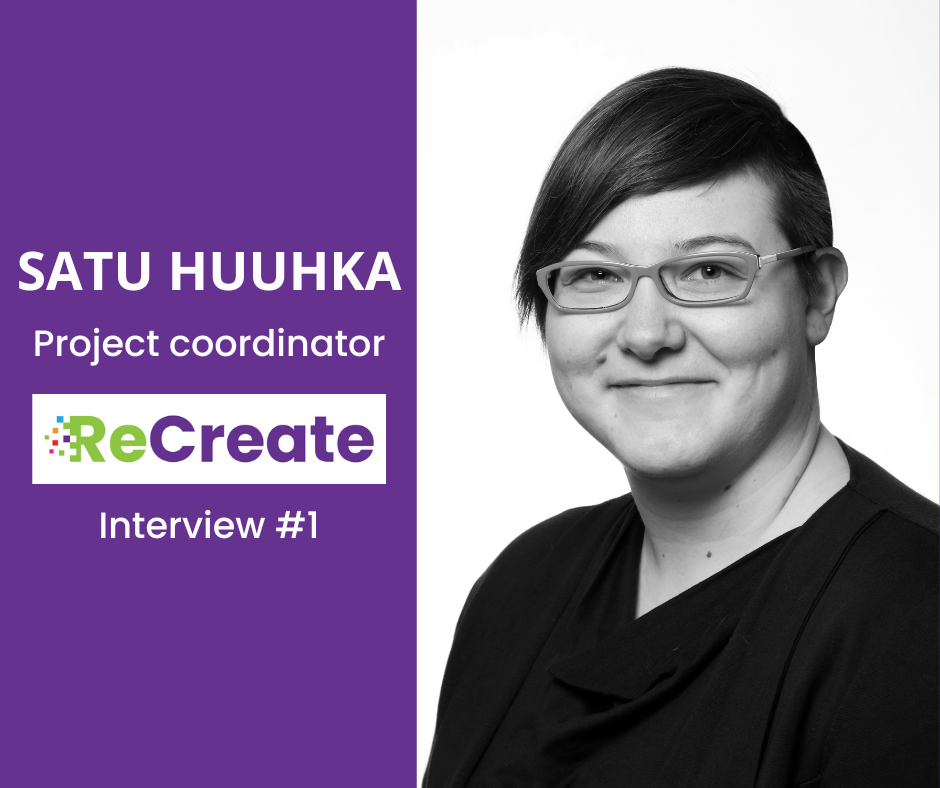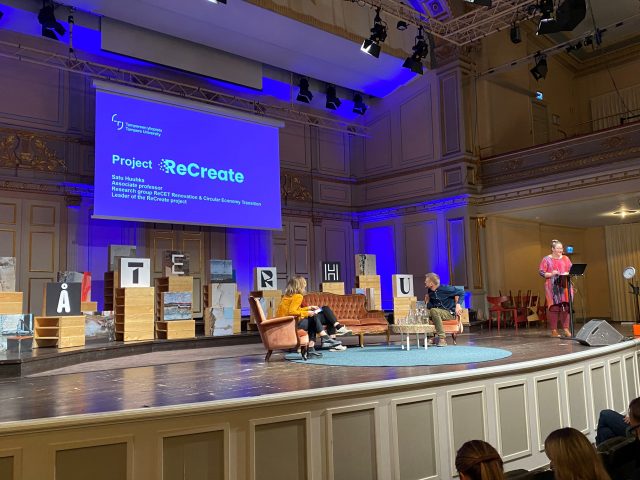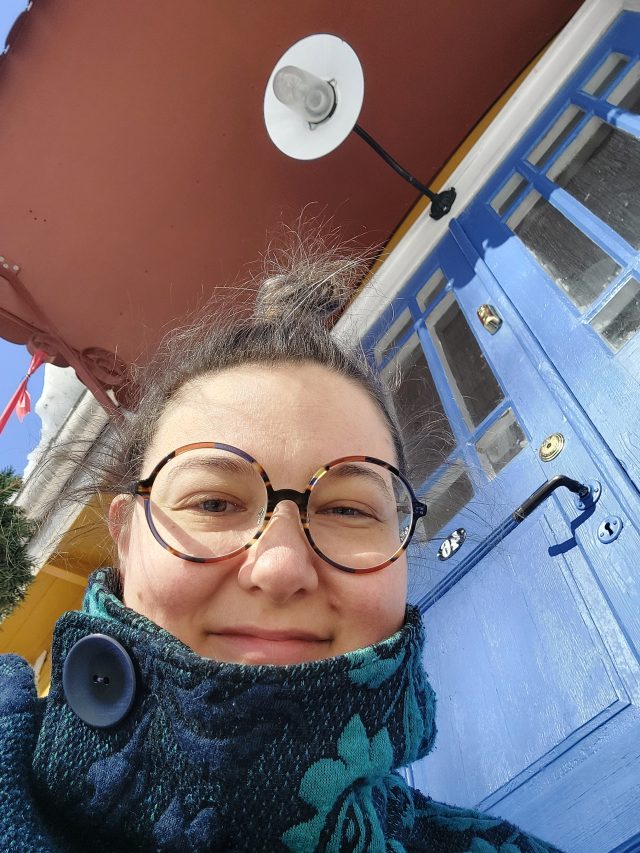
The success of the ReCreate project would not be possible without the expertise of people that stand behind it. Our first interviewee is Satu Huuhka – the project coordinator and the person most responsible for its inception. Ivan Fratrić of the Croatia Green Building Council will be conducting the interview. Here is her story:
I: Hi Satu! Can you introduce yourself a bit, tell us about your background, your role, as well as the role of your organization in the project?
Satu: I’m an associate professor of sustainable renovation at Tampere University School of Architecture. Tampere University is coordinating the organization and implementation of the project and I’m the scientific coordinator and basically the project is my brainchild as ReCreate was born of my initiative. I’m originally an architect and the topic of my masters degree was regarding the reuse of concrete or reusing different kinds of building parts and materials, but with a special focus on precast concrete. Interestingly, the inspiration for my masters thesis came from a relative of mine who sent me newspaper clippings of topics that I would possibly be interested in and one of those clippings was on the topic of reuse in Germany which I found the most intriguing and which incidentally described the work of professor Angelika Mettke who has worked on the topic for 20 years at that time and who would eventually join the leadership here on ReCreate. As for the idea for the project, it began with my colleague Jukka Lahdensivu who is the Work Package 4 leader and eventually ended up as multidisciplinary research, not just architectural and civil engineering, and employing a more holistic approach. My university supports preparing and coordinating proposals so I received a little grant to start building the consortium. Then we traveled to meet people from KTH and other organizations with whom we had previous contact and that we knew had suitable expertise to join the project. That’s how it started.
I: What was your initial idea when forming the consortium? What was the reasoning behind structuring it the way it is? How was the idea for the project received by the partners?
Satu: The idea for the country clusters was present from the beginning and was influenced by another project we are involved in which is called CIRCuIT which is coordinated by the city of Copenhagen but we’re a partner and a WP leader. I think that worked well in CIRCuIT and it made sense for ReCreate because we’re working with buildings, and construction is quite a local activity. It made sense to find universities to be country cluster leaders as they have the capacity to handle the management side of things, the bureaucracy, as well as because of their connections to the local organizations and industry partners that would address this issue in their countries. Everybody was really positive when they heard about the idea for the project and they immediately wanted to be on board, especially the universities. There was some difficulty with industrial partners as we had some talks with organizations that weren’t interested in the end, but our connections enabled us to find partners that wanted to be part of the project.
I: In essence, the universities immediately saw the potential of the project, while the industry needed more nudging in that direction.
Satu: The core activity of universities is research and development, but I think that industry partners were a bit weary of the bureaucracy which these projects entail. That is also why it was important to have these universities at the core of the country clusters to help the companies with the bureaucracy and to take the load off reporting away from companies as much as possible.
I: Of course, so they can focus on the development and implementation of the project.
Satu: Exactly, yes
I: Returning back to you. You said that the project is your brainchild and that it is personally very important to you. Why do you think, on a broader scale, the project is important and what is its ultimate goal?
Satu: It goes without saying that climate change is an issue, along with other environmental issues such as diminishing availability of sand and gravel in some locations. I think that now there’s a consensus in the construction sector that there’s need for change in the way how we’re building. Many European countries are even introducing legislation that requires low-carbon building – and not just with regards to the energy in operation. It is starting to be realized in the construction sector that manufacturing the materials for construction is also carbon intensive and that reusing building parts such as precast concrete helps to reduce that embodied carbon because in that case you don’t need to produce new material as you can just harvest existing elements from buildings that have been slated for demolition, which presents huge potential to cut embodied emissions as professor Mettke’s research has shown, and that’s the reason why we should look into reuse as concrete is used widely and is very carbon intensive as its a heavy material.

I: You’ve mentioned the potential for the reduction of greenhouse gasses and the depletion of raw materials. Do you have any other aspects of the project that you personally find most exciting and compelling?
Satu: I’d say its the multidisciplinary approach that we have. It’s fantastic that we have all these experts in their respective fields, which includes practical experts of the industry partners. The fact that we have these pilot buildings is also really important as I found through my own research that we have reached the limit on what we can do alone as researchers without actually trying it in practice. Since now we have these pilot buildings, our experts can really put their thought into it and what can become reality eventually – not just in the construction aspect, but also in business, the environmental impact, the social impact and how work is changing, what are the architectural implications are, what it means for logistics and digitalization. Seeing all these experts work together is really inspirational for me as I feel that we’re really making a step forward with reuse thanks to all of their expertise.
I: There’s no lack of exciting aspects to the project, but its sheer scope and complexity surely brings some sort of challenges with it. In your view, what is the most challenging aspect of ReCreate?
Satu: Before we started, I already had a preconception that we might have a conflict of interest between the partners or that maybe there would be a risk that the industrial partners would change their minds on whether this is something worth pursuing, but these concerns were not realized at all. All the partners are really invested. The most challenging aspect actually is aligning the ReCreate project timeline with the real world building project timeline, because we don’t want to do something that isn’t really needed as we’d like for the pilots to be buildings that would stay, which is not the case with the Swedish pilot, but in principle, we would like the buildings to stay, so we need these real world collaborations outside of the project to find suitable building projects. That has been a challenge in many locations and we are still working on it. The timelines of building projects are variable – sometimes things happen quickly and in other cases things can stop for years and can then be picked up again eventually.
I: Do you think that negative impact is short-termed or that it could create further issues down the line?
Satu: It’s more about the moment we’re in as it reminds us here in Europe that it’s important for us to be self – sufficient with building materials to mitigate these supply chain uncertainties in the global geopolitical landscape, which also then creates a strong argument for reusing materials that we have here at home.
I: We’ve touched upon it a bit, but I wanted to hear more from your perspective. The ReCreate project entails four different pilots, from four different countries, with a multitude of organizations and companies involved. How do you handle the coordination of all of that as it must be a challenge in itself?
Satu: It is challenging and I’m really lucky that I don’t have to do it alone. Soili Pakarinen’s help as the administrative coordinator is really valuable because she helps everybody with the financial reporting and the country cluster leaders (the universities) are my main contact point to the industrial partners in the other countries and vice versa as sometimes there are language issues as it’s easier for people to operate in their own languages. It is a team effort and Soili, the country cluster leaders, as well as work package leaders are very valuable. So basically I’m not alone because I’m surrounded and helped by brilliant people.
I: The project is really ambitious and we’ll definitely have something exciting to show at the end of it. How do you see the future of the ReCreate project? What kind of impact would you like for the project to have?
Satu: I hope that the industrial partners will be able to integrate the ReCreate approach into their daily business activities and that they will be able to provide these goods, services and expertise. That is our main pathway to impact – that these products and services become available on the market through our industrial partners. I’m also dedicated to keep helping them through new projects if there are still things that remain to be developed. Personally, I’m prepared to help other companies that want to engage in similar projects. Of course, there are also open access documents and publication that will be available for scientists, industry people and even regular people interested in the topic.
I: Thank you Satu for the interview. To end on a more personal note – who is Satu Huuhka and what does she like to do in her free time when she’s not managing the ReCreate project?
Satu: I’m a very work-oriented person but sometimes I do other things in my free time. I like to cook, read detective stories like good-old Agatha Christie. When I have more time, I like to do something with my hands. For example, I live in a traditional wooden Finnish house and I do the conservation work with my husband. Things like window conservation and new felt roofing on the outhouse, as well as furniture conservation.


